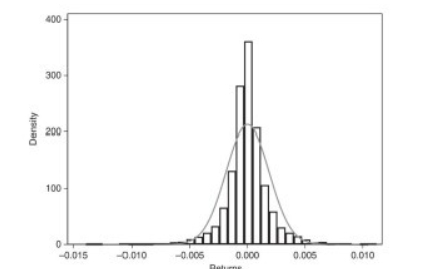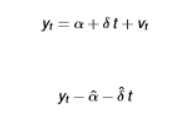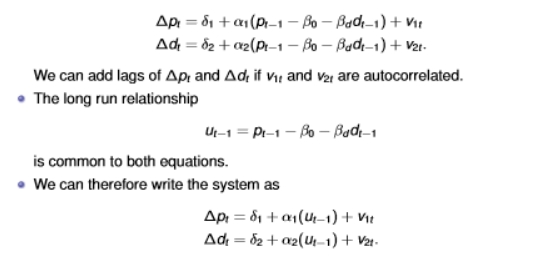Financial econometrics - terminology
1/134
There's no tags or description
Looks like no tags are added yet.
Name | Mastery | Learn | Test | Matching | Spaced |
|---|
No study sessions yet.
135 Terms
cash
represents a claim on the stream of services that it can secure by virtue of its roles as a medium of exchange
fixed-income securities
provide two sources of return:
a stream of interest payments (or coupons) that are made at fixed, regular intervals
the eventual return of principal at maturity
distinguishing feature: the periodic payment is known in advance
short-term assets whose markets are particularly active/liquid are known as money market fixed-income securities, eg treasury bills and eurodollar deposits
derivative securities
provide a payoff based on the value(s) of other assets such as commodities, bonds, or stocks
eg options and futures
options
the right to do so (not obliged) to buy or sell
offer the buyer the right (not the obligation) to buy (call) or sell (put) the underlying asset at a particular price during a certain period of time or on a specific date
futures
obligation to buy/sell at a future date
specify the delivery of either an asset or a cash value at a time known as the maturity for an agreed price, which is payable at maturity
equity securities
equities/common stock give the owner an equity stake in a company and a corresponding claim on company assets and earnings
bid
the highest price a buyer is willing to pay
ask
the lowest price a seller is willing to sell
market capitalisation
share price multiplied by the volume of outstanding shares
volume in box
volume of trade on that particular trade
not used in market capitalisation
stock market index
a summary measure of how well the stock market is doing as a whole
indices create portfolios by putting together a large group of stocks in a certain way
the index shows how much the portfolio is worth
expressed in terms of an average price that has been normalised in some way
over 1700 companies trading in London Exchange as of 2024
price-weighted index
the weight given to each stock is the price of the share
sum up the price of one share of each company gives the base for price-weighted index
value-weighted index
the weight given to each stock is proportional to the total market capitalisation
sum up the market capitalisation of all the companies gives the base for the value-weighted index
stylised facts
commonly observed patterns
integrated process
nonconstant mean and variance
leptokurtic distribution
a sharp peak in the centre of the distribution
slightly heavier tails
there are many observations where the exchange rate hardly moves and for which there are a greater number of smaller returns than there would be if returns were randomly drawn from a normal population
common in exchange, equity, and commodity markets

platykurtic distribution
lower peak and lighter tails than a normal distribution
moment
a snapshot of the shape of the distribution
volatility
how often the return deviates from the average return and how far it deviates
measures how risky an investment is
if volatility is high, then asset prices are changing more rapidly when volatility is low
the volatility of an asset can be measured by the standard deviation of its returns
sample covariance
a measure of co-movements between the returns on two assets
a positive covariance signifies that the returns of the assets move together
a negative covariance signifies that the returns of the assets move in opposite directions
percentile
a measure that indicates the value below which a given percentage of observations in the sample fall
for instance, the median, or the 50th percentile, has 50% of the observations below it
a set of statistics that summarize both the location and the spread of a distribution
inter-quartile range
the difference between the 25th percentile (first quartile) and the 75th percentile (third quartile)
provides an alternative to the standard deviation or variance as a measure of the dispersion of the distribution
value at risk (VaR)
quantifies the loss that a bank can face on its trading portfolio within a given period and for a given confidence interval
at a given level of confidence, VaR is the worst loss that won’t be exceeded over a certain period of time (typically one day)
1st and 5th percentiles are important when calculating this
quoted as a positive number
defined in terms of the lower tail of the distribution of trading revenues
autocorrelation
the strength of association between the current return, rt, and the return on the same asset k periods earlier, rt-k
used to test the predictability of returns
Efficient Market Hypothesis (EMH)
the idea that the market cannot be ‘beaten’
autocorrelation in squared terms
essentially the autocorrelation of the variance
measures the correlation between the variance of returns at time t, and the variance of returns at time t-k
treasury bills
simplest form of government debt
the government sells treasury bills in the money market and redeems them at the maturity of the bill (around 3, 6, 9 months)
no interest is payable during the life of the bill so they trade at discount to the face value of the bill that will be paid at maturity
eurodollar deposits
deposits of US banks that are denominated in US$ but held with banks outside the US
have relatively short maturity (<6 months)
the eurodollar deposit rate is used as a representative short-term interest rate
bond market
the place where longer term borrowing of governments or corporations is conducted
bond
a security that promises to pay the owner of the bond its face value at the time of maturity of the bond and usually an ongoing coupon payment prior to maturity
maturity can be as long as 30 years
zero-coupon bonds
pay no regular interest and are traded at prices below their face value
stripping
when zero-coupon bonds are created from coupon-paying bonds by separating the coupons from the principal and trading each of these components independently
long position
the entity who commits to purchase the asset on delivery
short position
the entity who commits to delivering the asset
risk-free rate
interest rate on a government bond
usually measured in annual rate so if calculating excess returns, need to ensure it is annualized
yield
the yield on a bond is the discount rate that equates the present value of the bond’s face value to its price
term structure
the relationship between time to maturity and yield to maturity
yield curve
a plot of the term structure of yield to maturity against time to maturity at a specific time
sample variance
a measure of the deviation of the actual return on an asset around its mean
sample standard deviation
a measure of the riskiness of an investment (volatility)
sample kurtosis
if there are extreme returns relative to a benchmark distribution
K>3 = more extreme returns in the data (heavier tails)
capital asset pricing model (CAPM)
a way of relating the risk of an asset to market risk
excess return
the return on asset i relative to risk-free rate rft
rit - rft
systematic risk
risk inherent to the entire market
nondiversifiable
market risk
this caused rhe 2008 financial crisis as firms could not change the equilibrium
idiosyncratic risk
diversifiable
asset-specific risk
white noise
a series that satisfies these conditions
means we have zero mean, homoskedastic variance, and zero autocorrelation

homoskedasticity
variance of ut is constant over time

objective function
a function we would like to miminise/maximise the function
we would like to reach that function
identity matrix
matrix in its inverse multiplied by the matrix itself
results in a matrix with ones in the diagonal and zeros elsewhere
has the nice property of leaving a vector unchanged
why it is called identity (keeps the identity of the vector)

Fama-French 3 factor model
Fama and French proposed to augment the VAPM model by including two additional risk factors to explain investment returns
these factors are referred to as size and value
size/small minus big (SMB) factor
accounts for the spread in returns between small- and large-sized firms
size is determined by market capitalisation = share price * number of shares outstanding
the performance of small stocks relative to big stocks
a risk factor to explain the return on a risky investment
value/high-minus-low (HML) factor
an additional factor that captures the performance of ‘value’ stocks relative to growth stocks
historic excess returns of (value stocks-growth stocks)
we average across the year
a risk factor to explain the return on a risky investment
value stocks
companies with high book-to-market ratios
the market is undervaluing the compnay
growth stocks
companies with low book-to-market ratios
the market is placing a high premium on expected future earnings or growth potential
book-to-market ratio
book value of firm
historical cost or accounting value/ market value of firm (market capitalisation
coefficient of determination (r-squared)
a natural measure of the success of an estimated model
it is the proportion of the variation in the dependent variable explained by the model
event analysis
used in empirical finance to model the effects of qualitative changes on financial variables arising from a discrete event
typical events that are relevant in finance arise from announcements such as the change in a company’s CEO, a monetary policy announcement, or dramatic new events
momentum factor
captures the returns to a portfolio constructed by buying stocks with high returns over the past 3 to 12 months and selling stocks with lower returns over the same period
captures the presence of herd behaviour among investors who are following market movements
structural equation
used in IV estimation
describe some aspect of the ‘structure’ of the economy or market
they carry behavioural content (eg how investors react to risk)
they are typically of the greatest interest to the modeller
they can contain one or more endogenous regressors, and cannot be consistently estimated by OLS

reduced form equation
expresses an endogenous variable exclusively in terms of exogenous variables
expresses an endogenous variable as a function of all of the exogenous and predetermined variables in the system
reduced form equations can only contain exogenous variables on the RHS
they can be consistently estimated by OLS
typically do not carry any behavioural interpretations
the estimated reduced form equation represents a weighted average of the exogenous and predetermined variables
weights are determined optimally in the sense that the estimated equation provides the best predictor of the endogenous variable from a conditional expectations point of view

identified structural equation
if there is at least one instrument for each endogenous variable
L(instruments)=N(endogenous regressors)
unidentified structural equation
the parameters of an unidentified equation cannot be consistently estimated
L (instruments)< N(endogenous regressors)
overidentified structural equation
L(instruments)>N(endogenous regressors)
relevant instrument
an instrument that satisfies the exogeneity condition
if this condition is not satisfied and the coefficient equals 0, the link between the two variables is broken
this means the instrument carries no information about the endogenous regressor xt

weak instrument
where the instrument does exhibit some correlation with xt but the correlation is relatively low
for example, if the coefficient was 0.001, we would have a problem
if the coefficient is small, then most of the information will translate intp et
this results in loss of information in et
endogenous variables
regressors that are correlated with the disturbance term
exogenous variables
regressors that are uncorrelated with the disturbance term
endogeneity problem
violation of the no-correlation assumption
endogeneity testing
testing a regressor for possible correlation with the disturbance term
reduced rank test
extension of testing framework for weak instruments, where there are N endogenous variables, L instruments, and K exogenous variables
based on a joint test of the quality of all possible instruments for the full set of endogenous regressors
valid instrument
satisfies the exogeneity condition and in the reduced form regression, the coefficient on the instrument does not equal zero
even though its value may be small so that weakness in this instrument is not precluded
can do robust testing despite this
anderson-rubin test
a t/F test of the null hypothesis
a condition that applies if zt is a valid instrument for xt and the relevance condition is met
if the hypothesis cannot be rejected, then B1 = 0 also can’t be rejected
weak instruments imply that π1 is small so that B1π1 is also small, also provided that B1 itself is not too large
if B1 is large, B1 will diverge substantially from its value under the nul hypothesis B1=0

tobin Q’s
the ratio of the market value of a company to the replacement cost of its assets
the logarithm of this can be used as a measure of firm performance
covariance stationary
a time series is said to be covariance stationary, if the mean, variance, and autocovariances all remain invariant to the time periods in which they are calculated
important as it allows us to build standard models and use the past behaviour of variables to extrapolate their behaviour in the future
requires that all joint distributions of the time series remain unchanged when shifted over time
it fails when the mean has a time trend, or when the variance is time varying
partial autocorrelation function (PACF) at lag k
measures the relationship between yt and yt-k
now the intermediate lags are included in the regression model, so that their effects are controlled for
another measure of the dynamic properties of AR models
vector autoregressive model (VAR)
with a multiply equation system where each variable is dependent on its own lags and the lags of all other variables
the assumption of covariance stationarity of all the variables is maintained
Granger causality
based on the presence/absence of predictability
does not of itself signify causal influence
Granger causality is a statistical concept used to determine whether past values of one time series help predict the current or future values of another time series, beyond what is possible using the past values of the dependent variable alone
granger causality testing
one method of identifying the system dynamic of a VAR and verifying block significance, thereby enhancing our understanding of variable interactions over time
impulse response analysis
used to examine system dynamics
focuses on impulse responses by tracking the transmission effects of shocks to the system on the dependent variables
shock
something happening to et that can’t be explained by y1, y2, y3
variance decomposition
we decompose the forecast variance into relative effects, expressed as percentages of the overall movement
in the case of the SVAR model of equities and dividends, the approach is to express the forecast error variances of equities and dividends in terms of the structural shocks v1 and v2
scalar (one variable) dynamic model
a single dependent financial variable is explained using its own past history as well as lags of other relevant financial variables
structural VAR models
allow for contemporeaneous interactive effects among the variables
an important characteristic for VAR is that each variable in the system is expressed as a linear function of its own lags as well as the lags of all of the other variables in the system
mean aversion in returns
exhibiting positive autocorrelations
mean reversion in returns
exhibiting negative autocorrelations
structural VAR
the disturbances v1t and v2t represent structural disturbances or primitive shocks that are uncorrelated E(v1t, v2t) = 0
this system can be used to construct impulse responses for ret and rdt, with respect to the structural shocks v1t and v2t
as the SVAR model is dynamic, the shocks have a contemporaneous effect as well as a dynamic effect
nonstationary time series
time series that exhibit strong evidence of trends over long periods of time - important property of asset prices
trend behaviour often manifests in a tendency for a time series to drift over time in such a way that no fixed mean value is revealed
this long term time trend is coupled with extended sub-periods in which prices wander above and below the trend line
may embody both a deterministic trend or a stochastic trend
order of integration
the process becomes stationary once differenced ‘d’ times
a process is integrated of order d, denoted by I(d), if it can be rendered stationary by differencing d times
trend-stationary
if de-trended yt is stationary
vt is stationary
most common is a linear trend but doesn’t have to be → d1t + d2²t

cointegration
the ability to generate stationary time series as a linear combination of nonstationary time series
occurs when two or more non-stationary time series are linked by a stable, long-run equilibrium relationship such that a linear combination of them is stationary
implies that while the series themselves may individually exhibit stochastic trends, they do not drift apart indefinitely
cointegrating parameters
the weights applied to each of the series in the combination
the convergence of the cointegrating parameters are faster than the stationary parameters
error correction model
system behaves in such a way as to correct the equilibrium errors, ut-1

impulse response analysis
in VAR or VECM, an impulse is like a sudden, unexpected shock
eg a sudden increase in interest rates
we are able to trace out how that shock affects each variable in the system over time
it helps us to understand causal dynamics - who influences whom and for how long
it can show whether a shock has temporary or permanent effects
variance decomposition
how much of the total forecast error (uncertainty) in each variable is due to shocks in itself vs shocks in other variables
ie, it splits up the forecast error variance into portions attributable to different shocks
deterministic trend
manifests in exponential growth path
stochastic process trend
arises from the accumulation of random forces that drive prices to wander above and below the path of the deterministic drift
stochastic trend component
aggregates (or integrates) up the component shocks vj
spurious regression problem
arises when two or more non-stationary time series are regressed on each other, leading to misleading high statistical significance, even when no real relationship exists
when variables are integrated of order one but not cointegrated, the standard OLS produces high r-squared values, significant t-statistics, standard tests may appear valid (even though they are not as they violate stationarity and no serial correlation assumptions)
in order to avoid the problem, the time series should be differenced
regression of two I(1) series may show high r-squared and t-stats, even when uncorrelated
forecast
a quantitative estimate about the most likely future value of a particular variable
typically based on past information and current information about the variable and other observable variables that are thought to be related to it
ex ante forecasts
the entire sample {y1, y2, …, yT} is used to estimate the model
the task is to forecast the variable y over the future horizon T+1 to T+H
uses all the information up to today and uses this information to forecast for the future
made before outcomes are known
it is useful for decision-making, unlike ex post forecasting